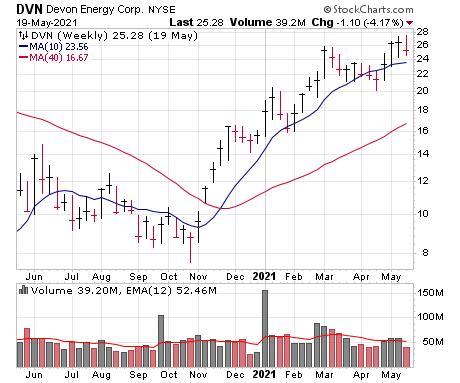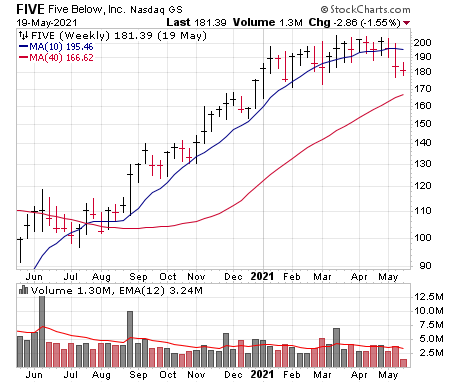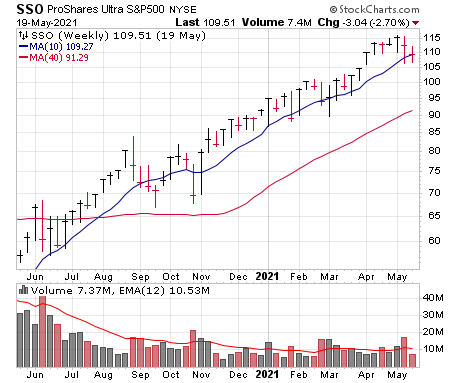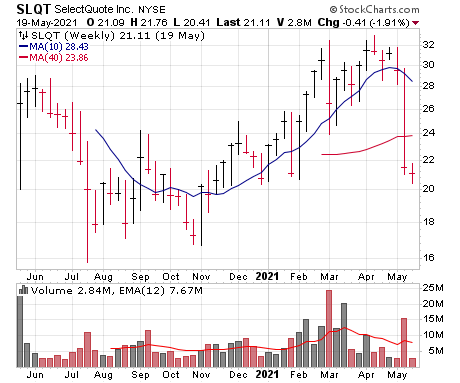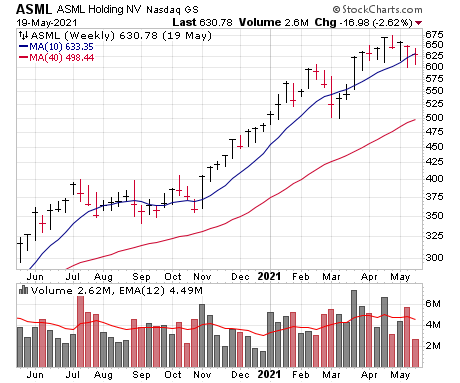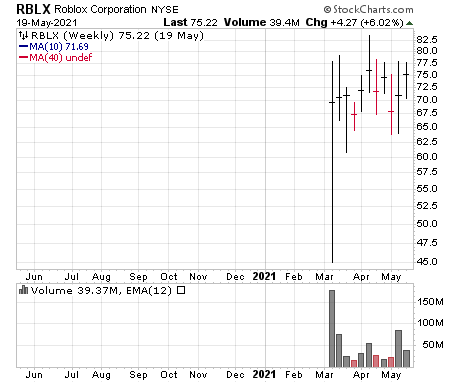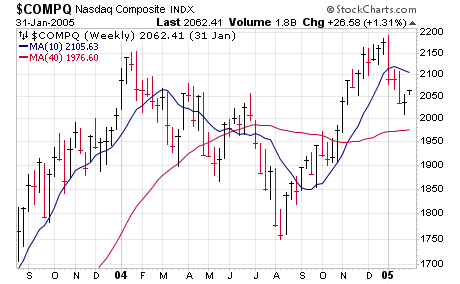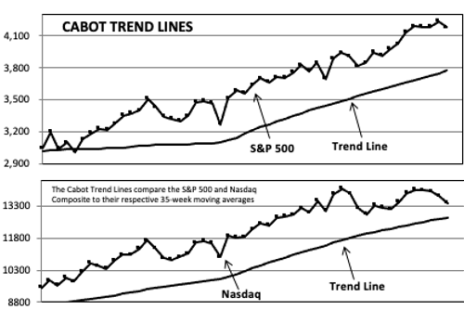Big picture, this year’s growth stock correction still looks normal, and encouragingly, we are now seeing some names bounce decently after the destruction of the prior two weeks. However, just going with the evidence, there’s still a lot of work to do, with few stocks in position to breakout and little in the way of upside power.
There will be another sustained rally (or two) down the road, but right now, we’re mostly biding our time, holding a lot of cash and fine tuning our watch list for whenever the buyers retake control.
In tonight’s issue, we dive into some precedent analysis that gives us confident in the big-picture point of view, and also highlight three new-ish additions to our watch list. In the Model Portfolio, we’re standing pat, but we could nibble if things continue to stabilize in the days ahead.
Cabot Growth Investor 1472
[premium_html_toc post_id="230812"]
Biding our Time
It’s been a downer of a three months for growth stocks, so we want to start with a positive note, partially in response to some worried questions we’ve started to get as the sellers really dug in their heels last week: Longer term, we remain as optimistic as ever that this bull market (yes, even in growth stocks) has a long way to run. Part of that is our still-bullish Cabot Trend Lines (bullish for more than a year now), but a lot of it comes from a study we write about later in this issue.
If you examine the market’s action in the years after huge upmoves (especially when those upmoves were born after a big decline, as we saw in 2020), it turns out that sloppy, tedious action over many months is quite normal—and it’s followed by another great rally. We’ll let you read all about it later on, but suffice it to say that we remain on the lookout for the next big money-making stretch.
However, just going with the evidence, that time is not now. The evidence with growth stocks ranges from choppy and challenging (the Nasdaq’s been bobbing and weaving since mid-February) to outright ugly, with many former leaders living below longer-term moving averages following 20% to 30% declines, yes, even after today’s bounce. Coming into today, two-thirds of Nasdaq stocks were below their 50-day lines, while nearly half were under their 200-day lines. We’re even seeing some of the selling spread to the broad market, as our Cabot Tides are on the fence.
To be fair, we have seen a couple rays of light during the past week. Many of the beaten-down growth names have begun to find support, even on bad news and when the market starts off weak; today was certainly a breath of fresh air. Sentiment is backing off, too, with some of the headlines of late (rockets in the Middle East, inflation, gas lines, etc.) reminiscent of what is often seen in the latter stages of a correction.
Overall, then, we’re keeping our head up and our eyes open; the past few weeks haven’t been fun, but we know the next sustained uptrend can more than make up for that. Right now, though, most growth titles are still in no man’s land, so we’re biding our time, waiting patiently for the bulls to take control.
What To Do Now
Remain defensive. We’ve had at least 45% in cash since early March, and today that figure is north of 70% after growth stocks fell left and right during earnings season. That’s a bit too high, so if things can stabilize for a few more days, we wouldn’t mind putting a little cash to work. But we’re comfortable waiting for some real strength before any major buying spree. We have no changes tonight.
Model Portfolio Update
Sometimes you’re the windshield and sometimes you’re the bug, and growth stocks have definitely been the latter during the past three weeks—the so-so rally starting in late March produced a decent number of setups, and in theory, if earnings season went well, there would have been a lot of names to sink our teeth into.
But earnings season did not go well—in fact, to be frank, it was one of the worst we can remember, with nearly every growth stock we track getting hammered in the days following their reports, leaving many below even longer-term moving averages (200-day lines). Thankfully, we had been in a cautious stance for a while (a bit above 50% in cash) and as stocks have collapsed left and right, we’ve moved to a defensive position (over 70% cash).
Of course, there are still some cyclical areas acting OK (though some are beginning to take on water), and we’re even seeing a few (just a few) growth names finally show some resilience. With so much cash, we won’t rule out a nibble or two in some resilient names if the buyers can show some real power and/or if a sector really gets going (energy?).
But remember that the big money is made in the big swing, so we advise remaining mostly patient and close to shore until we see signs of a sustained uptrend. That day will come, but until it does, there’s little point in forcing things while so many sellers remain active. Tonight, we’re standing pat, but will be on the horn if we have any new moves in the days ahead.
Current Recommendations
| Stock | No. of Shares | Portfolio Weightings | Price Bought | Date Bought | Price on 5/20/21 | Profit | Rating |
| Devon Energy (DVN) | 4022 | 5% | 26 | 5/7/21 | 25 | -1% | Buy a Half |
| Five Below (FIVE) | 852 | 8% | 138 | 9/18/20 | 182 | 32% | Hold |
| Floor & Décor (FND) | 1,004 | 5% | 107 | 4/9/21 | 100 | -7% | Hold |
| ProShares Ultra S&P 500 (SSO) | 1,741 | 10% | 60 | 5/29/20 | 112 | 86% | Buy |
| SelectQuote (SLQT) | — | — | — | — | — | — | Sold |
| CASH | $1,451,410 | 72% |
Devon Energy (DVN)—Energy stocks have been trying to get going during the past week or two, but they’ve mostly been up and down as the selling pressures have popped up in the cyclical area. Obviously, oil stocks could go poof if oil prices and cyclical stocks really roll over, but nothing has changed with the story, and we continue to think there’s a lot of upside in investor perception ahead—in Devon’s case, even at $50 oil (13 bucks below the current price), the firm should produce something like $2.25 in after-Capex free cash flow this year, and that figure includes a lot of hedge-related losses. (without those, free cash flow would be in the $3.75 per share range). And, of course, those figures could bump higher as production expands slowly going forward. When we added DVN, we went with just a half position, partly due to the market and partly because the sector may need more time to rest after its monster November-February advance, both of which are playing out now. Long story short, we still think DVN acts fine—we’re OK starting a position here or on dips of another point or so. BUY A HALF.
Five Below (FIVE)—Besides the re-implosion of many glamour stocks in the tech, biotech, cloud and Internet fields, the biggest thing we’ve seen over the past couple of weeks is the first signs of the selling spreading to other nooks and crannies of the market. FIVE was a good example, as the stock held near its highs while much of growth was taken out and shot in February, March and April, but finally came under the knife last week, getting hit hard for a couple of days before finding its footing. It’s never encouraging to see a stock hit the toboggan slide, and if you have a huge position or a big loss, you might want to trim and/or set a tight stop. But if you’ve been following us, we advise sitting tight with the stock because (a) the damage isn’t that bad at this point, just 11% or so off all-time highs, (b) we still have a healthy profit cushion, (c) we’ve already booked partial profits once (selling a third of our shares in early February) and (d) we’re already highly defensive in the portfolio. Obviously, if the market really falls apart, anything is possible, but we still see FIVE as a name big investors will support on dips—there simply aren’t many growth stories that have this dependability and this long of a runway of growth, with best-in-class store economics across the country (payback of new openings in less than a year). Moreover, as opposed to what most think, its average customer’s household earns $73,000 per year (actually above the average in the U.S.), including 27% that make six figures or more—thus, the firm isn’t just mining low income people, so the company should thrive no matter what the economic environment (boom times or no). Back to the stock, our leash isn’t limitless, but we’re OK giving FIVE more rope to correct and consolidate as we think the next major move is still up. HOLD.
Floor & Décor (FND)—Housing has been another area the sellers are now targeting—before finding support yesterday afternoon, the homebuilding fund (ITB) slipped a whopping 13% in less than two weeks for a variety of reasons (price inflation, possible Fed tightening, etc.), and that’s hit FND, which has gone from near new-high ground to falling back into its base. Fundamentally, business is humming here, and while growth will likely slow going forward from super-high rates (partly due to tougher comparisons in the second half of this year), this remains a unique long-term growth opportunity, with 20% annual store growth for years to come and a history of solid same-store growth, too. Even so, the company is not the stock, so our main focus is on the action. We started with just a half position due to the iffy-ness of the market, and we’re willing to give FND a chance to hold up—after thinking it over, we now have a mental stop in the low-90s; there should be a lot of support in that area (including the 200-day line), and 91 would be about a 15% loss. At this point, we advise gritting your teeth and hanging on. HOLD.
ProShares Ultra S&P 500 Fund (SSO)—There are many ways to try to make money in the market, but we have essentially been in favor of trend following (especially when it comes to market timing) since our founding in 1970 for a couple of reasons. First, if you make it a priority to always stick with the major trend, you’ll automatically be in every major, sustained upmove, and out of (or cautious during) every sustained downmove. Second, trends will often go farther than expected … so if you’re not trend following you’ll usually get in or out too early. All of that has played out to our benefit both since our initial purchase of SSO (when the 90% and 2-to-1 Blastoff indicators flashed nearly a year ago; both were amazing signals) and since early November (when another Blastoff measure, the Three Day Thrust, occurred). We’ve been riding SSO higher without much pressure for months, but now things are getting tricky, with the fund (and the S&P 500, as well as many other indexes) testing its 50-day line for the fifth time since November before its latest bounce. We don’t have a huge position in SSO, so if we do crack, we’ll have a decision to make—we’ll almost surely hold onto some, but whether we take partial profits or not will come down to some other factors (like breadth and the action of individual stocks). That said, we’ve made it a point to not anticipate what comes next, and right now, the S&P 500 has again held its 50-day line and our Cabot Tides are still hanging in there as well. Thus, we’ll stay on Buy, but we’ll see what comes in the days ahead. BUY.
SelectQuote (SLQT)—It seems like once or twice a year, if you’re investing in strong growth stocks, you’re going to get singed on earnings—and that’s exactly what happened with SLQT, which got creamed after cutting cash flow guidance due to a ramp in investments for some new offerings going ahead. Frankly, we’d probably buy SLQT again if the same set of circumstances presented themselves at our initial entry, as the stock was fresh, had shown big accumulation, was showing terrific relative strength and had a consistent record of executing (and of topping earnings estimates). But that’s the market for you, and there are no mulligans—with the stock blowing through our loss limit, we cut bait on our half-sized position last week. SOLD.
Watch List
- ASML Holding (ASML 649): ASML is a big-cap name, but chip equipment stocks are still resilient, and this firm has a monopoly in the systems that are needed to expand production of chips for the hottest markets (5G, AI, etc.). The stock has held its 50-day line during this growth correction; peer Applied Materials (AMAT) reports tonight, which could move the sector.
- CrowdStrike (CRWD 204): Of the stocks we’ve sold the past three months, CRWD is the only one that’s in reasonable position to get going if the market does. The pipeline hack helps perception, but there’s far more to the story than that, and its sales, earnings and recurring revenue growth are hard to beat. The stock has held its 200-day line (outperformance compared to many growth stocks) and is beginning to perk up. Earnings are due June 3.
- HubSpot (HUBS 503): HUBS has always been a challenging stock, but it’s changed character since the pandemic, and could be the next winner in the mega-theme of helping small-/mid-sized businesses do more online. See more below.
- Progeny (PGNY 57): Progeny has all of the makings of a winner, with a great story (unique, proven health insurance offerings focused on helping couples conceive), rapid and reliable growth (sales up 51% in Q1; earnings expected to rise 165% this year) and a resilient chart—PGNY has taken the occasional hit with the market but snapped back every time, including in recent days.
- Roblox (RBLX 76): Recent IPOs are always tricky and have presented a ton of landmines of late (go look at charts of PLTR, SNOW, ABNB and more), but RBLX looks like a rare bird, with the story, numbers and chart (positive reaction to earnings; huge liquidity) to be a winner. See more below.
- Shockwave Medical (SWAV 169): SWAV has had a big run during the past year and isn’t the most liquid stock, so it’s had every reason to get dragged down—but instead, shares remain perched near their highs after a blowout Q1 report. At this point SWAV is right at the top of our watch list.
Other Stocks of Interest
ASML Holdings (ASML 649)—ASML is a Dutch firm whose products are at the heart of the entire semiconductor industry—the company is the only producer of extreme ultraviolet (EUV) lithography machines, which were launched in 2017 and using light with wavelengths of just 13.5 nanometers to allow customers to etch smaller and smaller integrated circuits. The barriers to entry are huge, so all of the leading chipmakers out there (including Taiwan Semi, Intel and Samsung) are customers, and with a global chip shortage today and with many long-term growth drivers in the industry (5G, more advanced autos including electric vehicles, artificial intelligence, etc.), many are looking to rapidly expand production in the years ahead—boosting demand for ASML’s wares. (Taiwan Semi plans a $100 billion investment during the next three years, while Samsung just boosted its nine-year planned investment to $151 billion!) Eventually, there’ll likely be some overcapacity (so it goes in the chip sector), but the next few quarters at least should be boom times. ASML’s sales ramped all last year and growth accelerated wildly (up 90%) in Q1, with earnings more than tripling and crushing estimates. Management now sees sales up 30% or so this year while analysts expect the bottom line to rise 41%, though both of those should prove conservative. As for the stock, we see it as early-stage given the chip equipment sector just got going from a multi-year dead period last November. And ASML has shown very solid resilience during the growth stock maelstrom of the past three months, hitting new highs in April and holding its 10-week line. It’s not a small, young dynamo (market cap of $260 billion), but it certainly smells like a liquid leader, with its recent resilience a strong sign that big investors are building positions.
HubSpot (HUBS 503)—The vast majority of growth and glamour stocks are still circling the drain, but that makes it easier to spot the few that are holding well. One of those is HubSpot, which has always been a good company, but the stock has changed character during the past year and it’s still hanging around its 50-day line, which is practically heroic in this environment. The company could be next in line in the broad “helping digitize small business” theme, which has launched many winners (Square and Shopify are the two most notable) over the years—HubSpot is becoming the go-to marketing, sales and even website building platform for many small- and mid-sized businesses, focusing on what works these days (inbound marketing, such as free content and experiences that attract and keep users). And as everything has moved online, the firm’s solutions have gone from nice-to-have to need-it-now, and it’s even moving up the food chain, with enterprise offerings that can go up to $3,200 per month. With the right offerings at the right time, growth has picked up: Sales growth is accelerating (up 25%, 32%, 35% and 41% the past four quarters), free cash flow is solidly in the black (about $1.30 per share in Q1 alone) and its customer base is exploding (nearly 114,000 as of March, up 45% from a year ago)—though that’s just a small fraction of the three million potential customers it’s broadly targeting. HUBS has taken on some water during the growth selloff, but it’s far more resilient than most of its peers and has actually shown some tightness during the past couple of weeks, an initial sign that big investors are accumulating. Some more time could be needed, but HUBS is in great position to help lead the next growth stock advance, whenever it begins.
Roblox (RBLX 76)—We just wrote about Roblox in the last issue, but since then it’s reported Q1 results and we’ve been able to dig in even further—and we very much like what we see. We won’t repeat the general story (check the last issue for that), but we think the company can thrive not only as a gaming app, but also with huge expansion potential beyond that, including the potential for non-gaming 3D “worlds” that can be used for entertainment (virtual concerts), education (experience what it was like at such-and-such place at a time in history, etc.) and marketing (branded worlds that people can play in). Moreover, as the Q1 report showed, the company is moving beyond just an app for kids and into more of a mass market; total users leapt 79%, but over-13 users grew 111% and made up nearly half of the total user base, both here and overseas (user growth outside the U.S. and Canada surged 87%). Moreover, the earnings power here seems under-appreciated—while Roblox is unprofitable on an earnings basis, a lot of that has to do with how it recognizes revenues (in a word, gradually over time), which in turn means that free cash flow ($193 million in Q1, or about 34 cents per share) is skyrocketing. Of course, there’s little doubt that Roblox benefited from the stay-at-home pandemic lifestyle, so the growth figures are likely to slough off a bit, but there hasn’t been much of that so far, with April bookings up 8% from the prior month and user growth continuing. Because of all the good news, RBLX actually popped after its report (one of the few growth stocks to react well this earnings season) and isn’t far from its post-IPO high. Volatility is up there, but this is a rare, well-traded, rapidly-growing new issue that could be a magnet for institutional investors when the environment improves.
Big Picture, the Growth Correction Looks Normal
If you’re focused on growth stocks like us, then the past three months have obviously been a downer, and the near term still looks iffy following so many horrendous earnings reactions among growth stocks. However, we want to write about the fact that this correction—even if it goes on for a while longer—doesn’t appear abnormal from a big-picture point of view.
We say that not because of some rah-rah attitude, or because other areas of the market (cyclicals, etc.) are still doing OK. Instead, it comes from some studies of what often happens after a huge market up year, especially in the Nasdaq. It turns out that a fairly deep, multi-month correction is relatively normal—and is followed by another leg up.
Let’s take a look at some examples, the first of which is the huge rebound bull move of 2009, when the Nasdaq advanced 44% following the brutal prior-year meltdown. You can see that the year after ended up being a good one overall (Model Portfolio was up 27%), but almost all of that occurred starting in September with names like Priceline, Las Vegas Sands and Chipotle going bananas. Before that, it was a tough road: The Nasdaq suffered the “flash crash” in early May, lived under its 40-week line for a large part of the summer and, four months after the top, was still about 18% off its highs.
The aftereffects from the more-recent 2017 rally (Nasdaq up 28%) looked different, but still delivered two tough periods. After peaking in late January of 2018, the Nasdaq had a very sloppy 10%-plus correction for three months, and after another rally came the end-of-year, trade-war inspired 24% plunge, which finally gave way to an excellent 2019.
Before those two instances was the 2003 bear market recovery (Nasdaq up 50% after a 75%-plus decline the prior three years). Similar to the 2010 example, that led to a prolonged rough patch—the Nasdaq actually topped out in January 2004 and, while there were a couple of rally attempts, the index was sitting 19% off its highs about seven months after the peak. (The upmove after that didn’t get far into new high ground, but it was an excellent stretch—that’s when Apple and Google really began their mega-runs.)
Finally, further back was 1995, which saw the Nasdaq rally a huge 40%, though it did close the year with a few months of flat action. Still, after a strong rally into May 1996, the sellers showed up—the Nasdaq fell 19% from top to bottom and was still 10% off its highs three months from the peak while many speculative names back then (Iomega comes to mind) crashed 70% or more. However, starting in September, the buyers were back and the late-1990s bull market accelerated higher.
Of course, four examples are not the be-all and end-all of analysis, but the market is an odds game, and precedent analysis suggests (a) this year’s growth stock correction could go further both time-wise and price-wise, but (b) what we’re seeing is not unusual historically speaking. Even just looking at a year-long chart of the Nasdaq (see Cabot Trend Lines below), the past three months doesn’t look horrible—more like a tedious correction and consolidation after a massive run.
Short term it’s anyone’s guess, but until we see some real damage (like a Cabot Trend Lines sell signal and some obvious longer-term abnormal action among former leaders), we view this tedious stretch as setting up the next major upleg.
Is Sentiment Finally Faltering?
As students of the market, one of our main worries of late has been that few investors are worried about anything. But that might finally be changing, though we’d like to see more worry seep into the average Joe’s thoughts.
Our Real Money Index (see later in this issue) isn’t screaming buy, but it has backed off nicely in recent weeks. The NAAIM Exposure Index (measures the invested levels of many funds) skidded to its lowest (least bullish) level since April 2020 this week. The AAII Sentiment Survey saw a similar move, with the percent of bulls coming in at 37% each of the past two weeks, the lowest figures since last November’s blastoff.
We’re more focused on the primary price/volume/trend action of the market and leading stocks, but usually when a correction gets rolling for a while, it will often end when investors finally get discouraged (and often go along with a crystalizing piece of bad news). We’ve seen some improvement, though some more worry would present a higher-odds situation.
Cabot Market Timing Indicators
Growth stocks remain in an ugly correction, though so far, the rest of the market has been able to mostly keep its head above water—but with our Cabot Tides on the fence, the next few days should be key on that front. As growth investors, we remain cautious and patient, waiting for the buyers to retake control.
Cabot Trend Lines: Bullish
Our Cabot Trend Lines remain solidly bullish, though the market’s bifurcated stance is beginning to show—last week, the Nasdaq closed about 5% above its 35-week line, while the S&P 500 was above its own line by nearly 11%. Even so, this big-picture indicator doesn’t get into those details; with both indexes above their longer-term moving averages, the bull market remains alive and well.
Cabot Tides: On the Fence
Our Cabot Tides are effectively neutral, as more indexes have deteriorated—the Nasdaq, of course, has been struggling since mid-February, but now others (including the S&P 600 SmallCap, shown here) are bobbing and weaving near their 50-day lines. We don’t anticipate signals, so the Tides remain OK, but the intermediate-term trend is effectively neutral.
Cabot Real Money Index: Neutral
Sentiment has begun to ease, which is a plus, though we haven’t seen any hard-and-fast positive contrary signals. Our Real Money Index is a good example of this, as it’s backed off nicely from its exuberant peaks of a few weeks back, but we haven’t seen a stampede for the exits. Let’s see if that changes going forward.
Charts courtesy of StockCharts.com
The next Cabot Growth Investor issue will be published on June 3, 2021.
Cabot Wealth Network
Publishing independent investment advice since 1970.
President & CEO: Ed Coburn
Chairman & Chief Investment Strategist: Timothy Lutts
176 North Street, PO Box 2049, Salem, MA 01970 USA
800-326-8826 | support@cabotwealth.com | CabotWealth.com
Copyright © 2021. All rights reserved. Copying or electronic transmission of this information is a violation of copyright law. For the protection of our subscribers, copyright violations will result in immediate termination of all subscriptions without refund. No Conflicts: Cabot Wealth Network exists to serve you, our readers. We derive 100% of our revenue, or close to it, from selling subscriptions to its publications. Neither Cabot Wealth Network nor our employees are compensated in any way by the companies whose stocks we recommend or providers of associated financial services. Disclaimer: Sources of information are believed to be reliable but they are not guaranteed to be complete or error-free. Recommendations, opinions or suggestions are given with the understanding that subscribers acting on information assume all risks involved. Buy/Sell Recommendations: All recommendations are made in regular issues or email alerts or updates and posted on the private subscriber web page. Performance: The performance of this portfolio is determined using the midpoint of the high and low on the day following the recommendation. Cabot’s policy is to sell any stock that shows a loss of 20% in a bull market or 15% in a bear market from the original purchase price, calculated using the current closing price. Subscribers should apply loss limits based on their own personal purchase prices.

